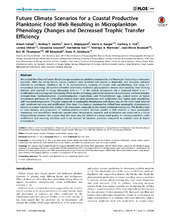Future climate scenarios for a coastal productive planktonic food web resulting in microplankton phenology changes and decreased trophic transfer efficiency
Calbet, Albert; Sazhin, Andrey F.; Nejstgaard, Jens Christian; Berger, Stella Angela; Tait, Zachary S.; Olmos, Lorena; Sousoni, Despoina; Isari, Stamatina; Martinez, Rodrigo A.; Bouquet, Jean-Marie; Thompson, Eric; Båmstedt, Ulf; Jakobsen, Hans H.
Peer reviewed, Journal article
Published version
Permanent lenke
https://hdl.handle.net/1956/9712Utgivelsesdato
2014-04-10Metadata
Vis full innførselSamlinger
Originalversjon
https://doi.org/10.1371/journal.pone.0094388Sammendrag
We studied the effects of future climate change scenarios on plankton communities of a Norwegian fjord using a mesocosm approach. After the spring bloom, natural plankton were enclosed and treated in duplicates with inorganic nutrients elevated to pre-bloom conditions (N, P, Si; eutrophication), lowering of 0.4 pH units (acidification), and rising 3°C temperature (warming). All nutrient-amended treatments resulted in phytoplankton blooms dominated by chain-forming diatoms, and reached 13–16 μg chlorophyll (chl) a l−1. In the control mesocosms, chl a remained below 1 μg l−1. Acidification and warming had contrasting effects on the phenology and bloom-dynamics of autotrophic and heterotrophic microplankton. Bacillariophyceae, prymnesiophyceae, cryptophyta, and Protoperidinium spp. peaked earlier at higher temperature and lower pH. Chlorophyta showed lower peak abundances with acidification, but higher peak abundances with increased temperature. The peak magnitude of autotrophic dinophyceae and ciliates was, on the other hand, lowered with combined warming and acidification. Over time, the plankton communities shifted from autotrophic phytoplankton blooms to a more heterotrophic system in all mesocosms, especially in the control unaltered mesocosms. The development of mass balance and proportion of heterotrophic/autotrophic biomass predict a shift towards a more autotrophic community and less-efficient food web transfer when temperature, nutrients and acidification are combined in a future climate-change scenario. We suggest that this result may be related to a lower food quality for microzooplankton under acidification and warming scenarios and to an increase of catabolic processes compared to anabolic ones at higher temperatures.

